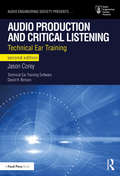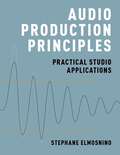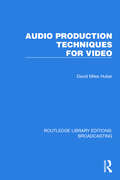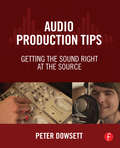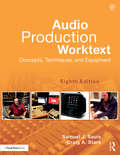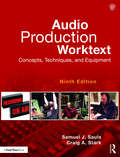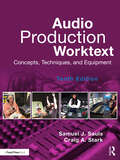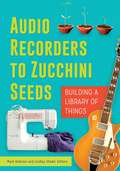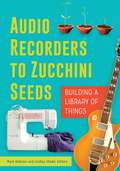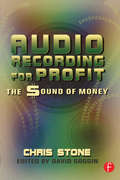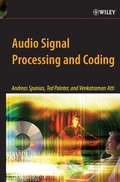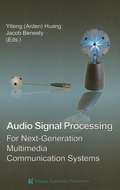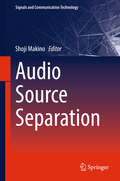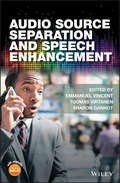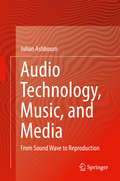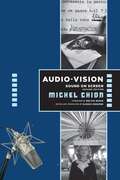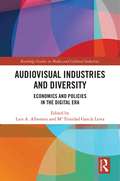- Table View
- List View
Audio Production and Critical Listening: Technical Ear Training (Audio Engineering Society Presents)
by Jason CoreyAudio Production and Critical Listening: Technical Ear Training, Second Edition develops your critical and expert listening skills, enabling you to listen to audio like an award-winning engineer. Featuring an accessible writing style, this new edition includes information on objective measurements of sound, technical descriptions of signal processing, and their relationships to subjective impressions of sound. It also includes information on hearing conservation, ear plugs, and listening levels, as well as bias in the listening process. The interactive web browser-based "ear training" software practice modules provide experience identifying various types of signal processes and manipulations. Working alongside the clear and detailed explanations in the book, this software completes the learning package that will help you train you ears to listen and really "hear" your recordings. This all-new edition has been updated to include: Audio and psychoacoustic theories to inform and expand your critical listening practice. Access to integrated software that promotes listening skills development through audio examples found in actual recording and production work, listening exercises, and tests. Cutting-edge interactive practice modules created to increase your experience. More examples of sound recordings analysis. New outline for progressing through the EQ ear training software module with listening exercises and tips.
Audio Production Principles: Practical Studio Applications
by Stephane ElmosninoWith this all-in-one manual, students and teachers have an easy-to-read reference that provides a reliable and current rundown of the world of sound production, from planning a recording session to mastering the final product. Organized by four main topics - pre-production, recording various instruments, mixing theories and tools, and mastering - Audio Production Principles follows the actual flow of instruction given over the course of a student's tenure. Chapters address etiquette and basic operations for any recording session written in useful, tutorial style language, providing guidelines for beginner audio engineers on topics including pre-production, equipment selection, and mixing tips by instrument. Jumpstarting the mastering process, lessons delve into features unique to specific tools and techniques. All sections offer instructional scenarios of studio setups, asking students to brainstorm the best production technique for each situation. These exercises also help teachers generate new ideas for instruction and production projects of their own.
AUDIO PRODUCTION PRINCIPLES C: Practical Studio Applications
by Stephane ElmosninoWith this all-in-one manual, students and teachers have an easy-to-read reference that provides a reliable and current rundown of the world of sound production, from planning a recording session to mastering the final product. Organized by four main topics - pre-production, recording various instruments, mixing theories and tools, and mastering - Audio Production Principles follows the actual flow of instruction given over the course of a student's tenure. Chapters address etiquette and basic operations for any recording session written in useful, tutorial style language, providing guidelines for beginner audio engineers on topics including pre-production, equipment selection, and mixing tips by instrument. Jumpstarting the mastering process, lessons delve into features unique to specific tools and techniques. All sections offer instructional scenarios of studio setups, asking students to brainstorm the best production technique for each situation. These exercises also help teachers generate new ideas for instruction and production projects of their own.
Audio Production Techniques for Video (Routledge Library Editions: Broadcasting #4)
by David Miles HuberAudio Production Techniques for Video (1987) looks at the mechanics and operation of audio tape and video tape recorders; audio and video synchronization-technology; studio and location audio production processes; video and audio post-production; troubleshooting time-code problems.
Audio Production Techniques for Video (Routledge Library Editions: Broadcasting #4)
by David Miles HuberAudio Production Techniques for Video (1987) looks at the mechanics and operation of audio tape and video tape recorders; audio and video synchronization-technology; studio and location audio production processes; video and audio post-production; troubleshooting time-code problems.
Audio Production Tips: Getting the Sound Right at the Source
by Peter DowsettAudio Production Tips: Getting the Sound Right at the Source provides practical and accessible information detailing the production processes for recording today’s bands. By demonstrating how to "get the sound right at the source," author Peter Dowsett lays the appropriate framework to discuss the technical requirements of optimizing the sound of a source. Through its coverage of critical listening, pre-production, arrangement, drum tuning, gain staging and many other areas of music production, Audio Production Tips allows you to build the wide array of skills that apply to the creative process of music production. Broken into two parts, the book first presents foundational concepts followed by more specific production advice on a range of instruments. Key features: Important in-depth coverage of music theory, arrangement and its applications. Real life examples with key references to the author’s music production background. Presents concepts alongside the production of a track captured specifically for the book. A detailed companion website, including audio, video, Pro Tools session files of the track recording process, and videos including accompanying audio that can be examined in the reader’s DAW. Please visit the accompanying companion website, available at www.audioproductiontips.com, for resources that further support the book’s practical approach.
Audio Production Tips: Getting the Sound Right at the Source
by Peter DowsettAudio Production Tips: Getting the Sound Right at the Source provides practical and accessible information detailing the production processes for recording today’s bands. By demonstrating how to "get the sound right at the source," author Peter Dowsett lays the appropriate framework to discuss the technical requirements of optimizing the sound of a source. Through its coverage of critical listening, pre-production, arrangement, drum tuning, gain staging and many other areas of music production, Audio Production Tips allows you to build the wide array of skills that apply to the creative process of music production. Broken into two parts, the book first presents foundational concepts followed by more specific production advice on a range of instruments. Key features: Important in-depth coverage of music theory, arrangement and its applications. Real life examples with key references to the author’s music production background. Presents concepts alongside the production of a track captured specifically for the book. A detailed companion website, including audio, video, Pro Tools session files of the track recording process, and videos including accompanying audio that can be examined in the reader’s DAW. Please visit the accompanying companion website, available at www.audioproductiontips.com, for resources that further support the book’s practical approach.
Audio Production Worktext: Concepts, Techniques, and Equipment
by Samuel J. Sauls Craig A. StarkThis is an excellent introduction to the modern radio production studio, the equipment found in that studio, and the basic techniques needed to accomplish radio production work. The new edition is updated throughout and features new sections on mobile technology, audio editing apps and software, and digital editing, as well as updated graphics and expanded content on portable digital audio players. Features a worktext/website format tailored for both students and teachers, offering a solid foundation for anyone who wishes to know more about radio/audio equipment and production techniques.
Audio Production Worktext: Concepts, Techniques, and Equipment
by Samuel J. Sauls Craig A. StarkThis is an excellent introduction to the modern radio production studio, the equipment found in that studio, and the basic techniques needed to accomplish radio production work. The new edition is updated throughout and features new sections on mobile technology, audio editing apps and software, and digital editing, as well as updated graphics and expanded content on portable digital audio players. Features a worktext/website format tailored for both students and teachers, offering a solid foundation for anyone who wishes to know more about radio/audio equipment and production techniques.
Audio Production Worktext: Concepts, Techniques, and Equipment
by Samuel J. Sauls Craig A. StarkAudio Production Worktext, 9th Edition provides readers the best introduction to audio and radio production. It shows how to navigate modern radio production studios and utilize the latest equipment and software. The 9th edition is updated to cover new mobile technologies, digital consoles, and audio editing apps and software, as well sound for the visual media and Internet radio. The new edition continues to include the worktext/website format tailored for both students and teachers and features like Production Tips that provide notes relevant to various audio production topics, self-study questions and projects, an updated Glossary, and an up-to-date companion website with invaluable student and instructor materials. Included in this edition are offers and features from Pro Sound Effects, FilmTVsound.com, and RadioFX, as well as updated color graphics and images throughout the text.
Audio Production Worktext: Concepts, Techniques, and Equipment
by Samuel J. Sauls Craig A. StarkAudio Production Worktext, 9th Edition provides readers the best introduction to audio and radio production. It shows how to navigate modern radio production studios and utilize the latest equipment and software. The 9th edition is updated to cover new mobile technologies, digital consoles, and audio editing apps and software, as well sound for the visual media and Internet radio. The new edition continues to include the worktext/website format tailored for both students and teachers and features like Production Tips that provide notes relevant to various audio production topics, self-study questions and projects, an updated Glossary, and an up-to-date companion website with invaluable student and instructor materials. Included in this edition are offers and features from Pro Sound Effects, FilmTVsound.com, and RadioFX, as well as updated color graphics and images throughout the text.
Audio Production Worktext: Concepts, Techniques, and Equipment
by Samuel J. Sauls Craig A. StarkNow in its tenth edition, the Audio Production Worktext offers a comprehensive introduction to audio production in radio, television, and film. This hands-on, student-friendly text demonstrates how to navigate modern radio production studios and utilize the latest equipment and software. Key chapters address production planning, the use of microphones, audio consoles, and sound production for the visual media. The reader is shown the reality of audio production both within the studio and on location. New to this edition is material covering podcasting, including online storage and distribution. The new edition also includes an updated glossary and appendix on analog and original digital applications, as well as self-study questions and projects that students can use to further enhance their learning. The accompanying instructor website has been refreshed and includes an instructor’s manual and PowerPoint images. This book remains an essential text for audio and media production students seeking a thorough introduction to the field.
Audio Production Worktext: Concepts, Techniques, and Equipment
by Samuel J. Sauls Craig A. StarkNow in its tenth edition, the Audio Production Worktext offers a comprehensive introduction to audio production in radio, television, and film. This hands-on, student-friendly text demonstrates how to navigate modern radio production studios and utilize the latest equipment and software. Key chapters address production planning, the use of microphones, audio consoles, and sound production for the visual media. The reader is shown the reality of audio production both within the studio and on location. New to this edition is material covering podcasting, including online storage and distribution. The new edition also includes an updated glossary and appendix on analog and original digital applications, as well as self-study questions and projects that students can use to further enhance their learning. The accompanying instructor website has been refreshed and includes an instructor’s manual and PowerPoint images. This book remains an essential text for audio and media production students seeking a thorough introduction to the field.
Audio Recorders to Zucchini Seeds: Building a Library of Things
by Mark Robison and Lindley Shedd, EditorsThis exploration of the range of options for a "library of things" collection demonstrates what has been implemented successfully and offers practical insights regarding these nontraditional projects, from the development of concepts to the everyday realities of maintaining these collections.What services libraries provide and how they function in their communities is constantly being reconsidered and redefined. One example of this is the trend of experimenting with building circulating collections of nonliterary "things"—such as tools, seeds, cooking equipment, bicycles, household machinery, and educational materials—by drawing on traditional library functions and strengths of acquisition, organization, and circulation. Audio Recorders to Zucchini Seeds: Building a Library of Things enables you to consider the feasibility of creating a specific type of "thing" collection in your library and get practical advice about the processes necessary to successfully launch and maintain it, from planning and funding to circulation, promotion, and upkeep.This contributed volume provides a survey of "library of things" projects within the United States, from both public and academic libraries, offering real-world lessons learned from these early experiments with nontraditional collections. The authors offer practical insights from their projects, from the development of their initial ideas to the everyday realities of maintaining and circulating these collections, including cataloging, space needs, safety concerns, staff training, circulation, marketing, and assessment. The contributed chapters are organized thematically, covering "things" collections that encompass a wide variety of objects first, followed by collections with a community-building focus (seeds, recreation, tools) and those that serve an educational purpose, such as curriculum centers, children's toys, or collections that support a university curriculum. The last section addresses collections that support media production.
Audio Recorders to Zucchini Seeds: Building a Library of Things
by Mark Robison Lindley SheddThis exploration of the range of options for a "library of things" collection demonstrates what has been implemented successfully and offers practical insights regarding these nontraditional projects, from the development of concepts to the everyday realities of maintaining these collections.What services libraries provide and how they function in their communities is constantly being reconsidered and redefined. One example of this is the trend of experimenting with building circulating collections of nonliterary "things"—such as tools, seeds, cooking equipment, bicycles, household machinery, and educational materials—by drawing on traditional library functions and strengths of acquisition, organization, and circulation. Audio Recorders to Zucchini Seeds: Building a Library of Things enables you to consider the feasibility of creating a specific type of "thing" collection in your library and get practical advice about the processes necessary to successfully launch and maintain it, from planning and funding to circulation, promotion, and upkeep.This contributed volume provides a survey of "library of things" projects within the United States, from both public and academic libraries, offering real-world lessons learned from these early experiments with nontraditional collections. The authors offer practical insights from their projects, from the development of their initial ideas to the everyday realities of maintaining and circulating these collections, including cataloging, space needs, safety concerns, staff training, circulation, marketing, and assessment. The contributed chapters are organized thematically, covering "things" collections that encompass a wide variety of objects first, followed by collections with a community-building focus (seeds, recreation, tools) and those that serve an educational purpose, such as curriculum centers, children's toys, or collections that support a university curriculum. The last section addresses collections that support media production.
Audio Recording for Profit: The Sound of Money
by Chris StoneThis book is the first real inside look at the business of professional audio recording, which fuels a multibillion dollar global music industry. Industry pioneer Chris Stone, founder of the legendary Record Plant, provides hard-earned business strategies, guidelines, and advice on every aspect of launching and managing a professional audio recording business. This book is for every audio profit center - from the project studio in the garage to the multi-room diversified recording facility. With 30 years of practical business experience, Mr. Stone reveals the secrets of profitable survival in the pro audio world of today and tomorrow. Why be a player in the professional audio recording industry? What is the attraction and potential payoff? How big an operation are you contemplating? To succeed, one must categorize the various types and sizes of pro audio facilities and their customer bases. It is also essential to understand creative management, marketing, promotion, and the modern economics of pro audio. The professional of tomorrow anticipates recording for new media and is prepared for diversification. All of these issues and more are addressed in this book.
Audio Recording for Profit: The Sound of Money
by Chris StoneThis book is the first real inside look at the business of professional audio recording, which fuels a multibillion dollar global music industry. Industry pioneer Chris Stone, founder of the legendary Record Plant, provides hard-earned business strategies, guidelines, and advice on every aspect of launching and managing a professional audio recording business. This book is for every audio profit center - from the project studio in the garage to the multi-room diversified recording facility. With 30 years of practical business experience, Mr. Stone reveals the secrets of profitable survival in the pro audio world of today and tomorrow. Why be a player in the professional audio recording industry? What is the attraction and potential payoff? How big an operation are you contemplating? To succeed, one must categorize the various types and sizes of pro audio facilities and their customer bases. It is also essential to understand creative management, marketing, promotion, and the modern economics of pro audio. The professional of tomorrow anticipates recording for new media and is prepared for diversification. All of these issues and more are addressed in this book.
Audio Signal Processing and Coding
by Andreas Spanias Ted Painter Venkatraman AttiAn in-depth treatment of algorithms and standards for perceptual coding of high-fidelity audio, this self-contained reference surveys and addresses all aspects of the field. Coverage includes signal processing and perceptual (psychoacoustic) fundamentals, details on relevant research and signal models, details on standardization and applications, and details on performance measures and perceptual measurement systems. It includes a comprehensive bibliography with over 600 references, computer exercises, and MATLAB-based projects for use in EE multimedia, computer science, and DSP courses. An ftp site containing supplementary material such as wave files, MATLAB programs and workspaces for the students to solve some of the numerical problems and computer exercises in the book can be found at ftp://ftp.wiley.com/public/sci_tech_med/audio_signal
Audio Signal Processing for Next-Generation Multimedia Communication Systems
by Jacob Benesty Yiteng Arden HuangAudio Signal Processing for Next-Generation Multimedia Communication Systems presents cutting-edge digital signal processing theory and implementation techniques for problems including speech acquisition and enhancement using microphone arrays, new adaptive filtering algorithms, multichannel acoustic echo cancellation, sound source tracking and separation, audio coding, and realistic sound stage reproduction. This book's focus is almost exclusively on the processing, transmission, and presentation of audio and acoustic signals in multimedia communications for telecollaboration where immersive acoustics will play a great role in the near future.
Audio Source Separation (Signals and Communication Technology)
by Shoji MakinoThis book provides the first comprehensive overview of the fascinating topic of audio source separation based on non-negative matrix factorization, deep neural networks, and sparse component analysis. The first section of the book covers single channel source separation based on non-negative matrix factorization (NMF). After an introduction to the technique, two further chapters describe separation of known sources using non-negative spectrogram factorization, and temporal NMF models. In section two, NMF methods are extended to multi-channel source separation. Section three introduces deep neural network (DNN) techniques, with chapters on multichannel and single channel separation, and a further chapter on DNN based mask estimation for monaural speech separation. In section four, sparse component analysis (SCA) is discussed, with chapters on source separation using audio directional statistics modelling, multi-microphone MMSE-based techniques and diffusion map methods. The book brings together leading researchers to provide tutorial-like and in-depth treatments on major audio source separation topics, with the objective of becoming the definitive source for a comprehensive, authoritative, and accessible treatment. This book is written for graduate students and researchers who are interested in audio source separation techniques based on NMF, DNN and SCA.
Audio Source Separation and Speech Enhancement
by Emmanuel Vincent Tuomas Virtanen Sharon GannotLearn the technology behind hearing aids, Siri, and Echo Audio source separation and speech enhancement aim to extract one or more source signals of interest from an audio recording involving several sound sources. These technologies are among the most studied in audio signal processing today and bear a critical role in the success of hearing aids, hands-free phones, voice command and other noise-robust audio analysis systems, and music post-production software. Research on this topic has followed three convergent paths, starting with sensor array processing, computational auditory scene analysis, and machine learning based approaches such as independent component analysis, respectively. This book is the first one to provide a comprehensive overview by presenting the common foundations and the differences between these techniques in a unified setting. Key features: Consolidated perspective on audio source separation and speech enhancement. Both historical perspective and latest advances in the field, e.g. deep neural networks. Diverse disciplines: array processing, machine learning, and statistical signal processing. Covers the most important techniques for both single-channel and multichannel processing. This book provides both introductory and advanced material suitable for people with basic knowledge of signal processing and machine learning. Thanks to its comprehensiveness, it will help students select a promising research track, researchers leverage the acquired cross-domain knowledge to design improved techniques, and engineers and developers choose the right technology for their target application scenario. It will also be useful for practitioners from other fields (e.g., acoustics, multimedia, phonetics, and musicology) willing to exploit audio source separation or speech enhancement as pre-processing tools for their own needs.
Audio Source Separation and Speech Enhancement
by Emmanuel Vincent Tuomas Virtanen Sharon GannotLearn the technology behind hearing aids, Siri, and Echo Audio source separation and speech enhancement aim to extract one or more source signals of interest from an audio recording involving several sound sources. These technologies are among the most studied in audio signal processing today and bear a critical role in the success of hearing aids, hands-free phones, voice command and other noise-robust audio analysis systems, and music post-production software. Research on this topic has followed three convergent paths, starting with sensor array processing, computational auditory scene analysis, and machine learning based approaches such as independent component analysis, respectively. This book is the first one to provide a comprehensive overview by presenting the common foundations and the differences between these techniques in a unified setting. Key features: Consolidated perspective on audio source separation and speech enhancement. Both historical perspective and latest advances in the field, e.g. deep neural networks. Diverse disciplines: array processing, machine learning, and statistical signal processing. Covers the most important techniques for both single-channel and multichannel processing. This book provides both introductory and advanced material suitable for people with basic knowledge of signal processing and machine learning. Thanks to its comprehensiveness, it will help students select a promising research track, researchers leverage the acquired cross-domain knowledge to design improved techniques, and engineers and developers choose the right technology for their target application scenario. It will also be useful for practitioners from other fields (e.g., acoustics, multimedia, phonetics, and musicology) willing to exploit audio source separation or speech enhancement as pre-processing tools for their own needs.
Audio Technology, Music, and Media: From Sound Wave to Reproduction
by Julian AshbournThis book provides a true A to Z of recorded sound, from its inception to the present day, outlining how technologies, techniques, and social attitudes have changed things, noting what is good and what is less good. The author starts by discussing the physics of sound generation and propagation. He then moves on to outline the history of recorded sound and early techniques and technologies, such as the rise of multi-channel tape recorders and their impact on recorded sound. He goes on to debate live sound versus recorded sound and why there is a difference, particularly with classical music. Other topics covered are the sound of real instruments and how that sound is produced and how to record it; microphone techniques and true stereo sound; digital workstations, sampling, and digital media; and music reproduction in the home and how it has changed. The author wraps up the book by discussing where we should be headed for both popular and classical music recording and reproduction, the role of the Audio Engineer in the 21st century, and a brief look at technology today and where it is headed. This book is ideal for anyone interested in recorded sound. “[Julian Ashbourn] strives for perfection and reaches it through his recordings… His deep knowledge of both technology and music is extensive and it is with great pleasure that I see he is passing this on for the benefit of others. I have no doubt that this book will be highly valued by many in the music industry, as it will be by me.” -- Claudio Di Meo, Composer, Pianist and Principal Conductor of The Kensington Philharmonic Orchestra, The Hemel Symphony Orchestra and The Lumina Choir
Audio-vision: Sound on Screen
by Michel Chion Claudia GorbmanMichel Chion’s landmark Audio-Vision has exerted significant influence on our understanding of sound-image relations since its original publication in 1994. Chion argues that sound film qualitatively produces a new form of perception. Sound in audiovisual media does not merely complement images. Instead, the two channels together engage audio-vision, a special mode of perception that transforms both seeing and hearing. We don’t see images and hear sounds separately―we audio-view a trans-sensory whole. In this updated and expanded edition, Chion considers many additional examples from recent world cinema and formulates new questions for the contemporary media environment. He takes into account the evolving role of audio-vision in different theatrical environments, considering its significance for music videos, video art, commercial television, and the internet, as well as conventional cinema. Chion explores how multitrack digital sound enables astonishing detail, extending the space of the action and changing practices of scene construction. He demonstrates that speech is central to film and television and shows why “audio-logo-visual” is a more accurate term than “audiovisual.” Audio-Vision shows us that sound is driving the creation of a sensory cinema. This edition includes a glossary of terms, a chronology of several hundred significant films, and the original foreword by sound designer, editor, and Oscar honoree Walter Murch.
Audio-Visual Industries and Diversity: Economics and Policies in the Digital Era (Routledge Studies in Media and Cultural Industries)
by Luis A. Albornoz Mª Trinidad García LeivaThis book reflects critically on issues of diversity, access, and the expansion of digital technologies in audio-visual industries, particularly in terms of economics and policies. It brings together specialists in cultural diversity and media industries, presenting an international and interdisciplinary collection of essays that draw from different fields of studies – notably Communication, Economics, Political Science and Law. Among the topics discussed are: the principle of diversity as a goal of cultural and communication policies, the assessment of the UNESCO Convention on Cultural Diversity, free trade agreements and the conception of cultural goods and services they advance, the challenges faced by the production, circulation and consumption of cultural content through the Internet, the role algorithms play in the organization and functioning of online platforms, Netflix and the hegemony of global media. The approach is a critical understanding of audio-visual diversity, that aims to transcend specific issues like media ownership, ideas portrayed or modes of consumption as such, to focus on a more balanced distribution of communicative power. This volume is an essential read for scholars and researchers in Communication Studies, Economy of Culture, International Relations and International Law, as well as policy makers, journalists specialized in media and culture, and managers of public and private institutions involved in the development of cultural and communication policies. Postgraduate students will find it a key reference point.
